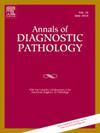Utility and limitations of Merlin immunohistochemistry for mesothelioma diagnosis in tissue sections and cell blocks
IF 1.4
4区 医学
Q3 PATHOLOGY
引用次数: 0
Abstract
Distinguishing pleural mesothelioma (PM) from reactive mesothelial proliferations (RMP) can be challenging. In such cases, immunohistochemistry (IHC)-detected BAP1 or MTAP loss and FISH-detected CDKN2A homozygous deletion are effective. Merlin is the protein product of the NF2 gene, which is frequently altered in mesotheliomas. Recently, IHC-detected loss of Merlin was also shown to be useful in differentiating PM from RMP. To validate these findings, we examined Merlin IHC in PM cases, including for the first time cytologic material. Merlin IHC was performed on 67 PM cases, including 47 samples from tissues and 20 from cell blocks (CBs), and 29 RMP cases. In RMP, Merlin was expressed in cell membranes and cytoplasm, with no loss. Merlin expression was lost in 49 % of PM tissues. In discriminating PM from RMP, addition of Merlin IHC to the combination of BAP1 and MTAP IHC increased sensitivity from 77 % to 95 %. However, Merlin expression could not be assessed in 8.5 % of tissues and 25 % of CBs. In CBs, Merlin loss could be assessed only in sheeted or clustered tumor cells, because PM cells could not be identified precisely in few scattered tumor cells. In cases where both tissue biopsy and CBs were available, results matched in only 50 % of cases, suggesting uneven occurrence of Merlin loss in PM tissues. Our observations support the effectiveness of Merlin IHC in differentiating PM from RMP. However, investigators should be familiar with potential challenges in interpreting Merlin IHC results, especially in CBs.
Merlin免疫组织化学在组织切片和细胞块诊断间皮瘤中的应用和局限性
区分胸膜间皮瘤(PM)和反应性间皮瘤增生(RMP)是具有挑战性的。在这种情况下,免疫组织化学(IHC)检测BAP1或MTAP缺失和fish检测CDKN2A纯合缺失是有效的。Merlin是NF2基因的蛋白产物,该基因在间皮瘤中经常发生改变。最近,ihc检测到的Merlin缺失也被证明有助于区分PM和RMP。为了验证这些发现,我们首次检查了PM病例中的Merlin IHC,包括细胞学材料。对67例PM进行了Merlin免疫组化,包括47例组织样本和20例细胞块(CBs)样本,以及29例RMP病例。在RMP中,Merlin在细胞膜和细胞质中表达,没有损失。49%的PM组织丢失了Merlin的表达。在区分PM和RMP时,在BAP1和MTAP IHC的组合中加入Merlin IHC将敏感性从77%提高到95%。然而,8.5%的组织和25%的CBs无法检测到Merlin的表达。在CBs中,由于PM细胞不能在少数分散的肿瘤细胞中精确鉴定,因此只能在片状或聚集的肿瘤细胞中评估Merlin损失。在组织活检和CBs都可用的情况下,结果只有50%的病例匹配,这表明梅林丢失在PM组织中的发生不均匀。我们的观察结果支持Merlin IHC在鉴别PM和RMP方面的有效性。然而,研究者应该熟悉解释Merlin IHC结果的潜在挑战,特别是在CBs中。
本文章由计算机程序翻译,如有差异,请以英文原文为准。
求助全文
约1分钟内获得全文
求助全文
来源期刊
CiteScore
3.90
自引率
5.00%
发文量
149
审稿时长
26 days
期刊介绍:
A peer-reviewed journal devoted to the publication of articles dealing with traditional morphologic studies using standard diagnostic techniques and stressing clinicopathological correlations and scientific observation of relevance to the daily practice of pathology. Special features include pathologic-radiologic correlations and pathologic-cytologic correlations.

 求助内容:
求助内容: 应助结果提醒方式:
应助结果提醒方式:


